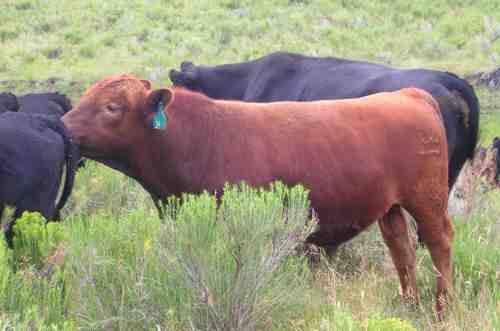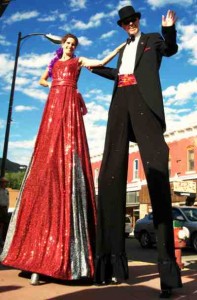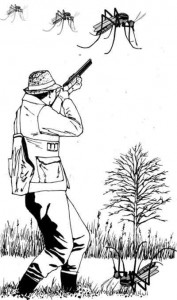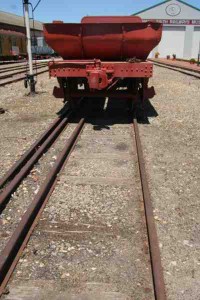Column by Hal Walter
Agriculture – August 2007 – Colorado Central Magazine
I’D NEVER BOUGHT A BULL, but there I was, standing in a pen of 11 yearling Red Angus at Smith Land and Cattle near Fort Garland, trying to choose one out of the crowd.
After looking over all the red bulls carefully, three of them stood out. They wore eartags 3R, 34R and 51R.
A little background as to why I was in the market for a bull might be in order. I manage a small horse and cattle ranch just up the road from my home in the Wet Mountains. The owners, Ross and Jan Wilkins, had just one cow when they hired me two years ago and set me to the task of finding some more cattle. I had the notion that we should get into natural grassfed beef.
I’d recently attended a talk by Jo Robinson, a proponent of pasture-based ranching and author of the book Pasture Perfect. I was sold — and still am — on the idea that cattle raised only on grass and other forage were healthiest for the range, the environment, and for the people who eat them.
That was fine with Ross and Jan, and they sent me out with a checkbook to buy some cattle for their operation, which includes a 640-acre mountain pasture lease.
A friend of mine, Doug Wiley, was already into the natural grassfed beef business and was eager to partner with us. We came up with an arrangement whereby the cattle would spend their summers here in the mountains, and winters at Doug’s ranch near Avondale, east of Pueblo. Doug had willing buyers for his beef and our plan was to spin off any meat animals to his program while we built the herd.
Other than that, I had no experience buying cattle at that point, but nonetheless came home with five clean cow-calf pairs and four heifers. They were mostly black Angus/Maine Anjou composites and had never been given any antibiotics or other drugs.
But we had no bull, and without a bull there can be no beef production. That first summer I made a deal with some neighbors who had a bull of the type that is called a “Black Baldy.” These cattle are black with a white face and are produced by crossing a Hereford with a black Angus. Black Baldies are popular around here because of their adaptability to the altitude and their “hybrid vigor.”
Our arrangement was that we would pasture the bull and a few cows and calves in exchange for the breeding. The deal proved to be less than ideal, however, because the cows that came with the bull kept breaking down the fences and getting out. Finally the owner took the bull and cows home, but luckily not before all of our cows and heifers were bred. The next spring we had nine calves from that bull.

The second summer I arranged to lease a bull. This bull was a composite Angus/Maine-Anjou/shorthorn engineered to produce 4H show calves. This spring Doug had to pull three calves during birth. We lost one heifer and her calf at birth, and one calf was born deformed and had to be put down. Once again we had nine live calves. With our herd now approaching 30 head, it was becoming increasingly clear that we had grown past the point of borrowing or leasing a bull. Plus, the calving problems had us thinking that we really needed to put some effort into genetics if we wanted to raise good cattle.
SO ONCE AGAIN I went shopping. Doug really wanted a red Angus bull for our herd because of the breed’s ability to produce excellent beef from grass. But our area is really Hereford and Black Baldy country, and Angus can be tricky at altitude. I made some calls and went to look at some local Hereford bulls. I checked the Internet and found an Angus breeder in Mosca. I called and left a message.
I had already given up on finding a bull on the other side of the Sangres when a couple days later the rancher returned my call. He said that his Angus herd was one of the oldest in the state and well adapted to the high altitude, but that he had sold all of this year’s bulls. However, he said his nephew raised red Angus in Fort Garland and he thought he might still have some bulls for sale. He gave me a cell phone number.
I called the nephew, TJ Smith, and explained to him how I’d gotten his number, what we were trying to do with our cattle and what I was looking for in a bull. “We’ve got ’em!” he said matter-of-factly.
A few days later I was in the pen trying to decide among 3R, 34R and 51R. TJ’s bull program is quite sophisticated and he has not only the basic breeding information for each bull, but also a set of numbers and ratios. For Angus that will be living at high altitude an important test is for pulmonary arterial pressure, or PAP. A score of 45 or less is best if you want to lower the risk for brisket disease, also known as high mountain disease or dropsy, in this breed at high altitude. 3R had a PAP of 41, 34R had a 37, and 51R had a 39.
But there were other numbers to consider as well. There were figures for the square inches of ribeye steak, intermuscular fat, marbling, birth weigh, weanling weight, and other factors related to beef production.
After considering all of these numbers, I decided upon 51R. We loaded him into the trailer. I wrote TJ a check for $1,750, and soon I was following Kit Carson’s old route back to Westcliffe with our new bull. He was truly a beautiful animal and the picture of everything I thought a bull should be.
I turned 51R out in the pasture that fine summer evening. He stepped calmly out of the trailer. He sniffed around the ramshackle corral. He surveyed the bountiful green grass and the spring water running through the property. Then off in the distance one of the cows mooed and he lifted his head and cocked an ear. He looked my way and I could see that he viewed me as some sort of deity. I had, after all, delivered him unto heaven.
FOR THE NEXT WEEK, 51R ran with the cows. Then he disappeared for three days. I searched the school section for hours and couldn’t find him. Then one evening he simply reappeared out of the brush, a red bull grazing in the green grass. It was a pretty sight.
I could only guess he had needed a rest from the good life. For the next week he was once again mingling with the cows, and one morning he was spotted actually performing in his official capacity.
Then one day, just two weeks after I had put him in with the cows, Jan called to tell me that 51R was found dead. After the initial disbelief, I went over to inspect the carcass.
There he lay, on his right side in the open near the top of a low hill. There was no sign of struggle, or of any reason he should have died. A sick animal surely would have sought out lower ground and cover. Though I initially saw no obvious evidence of singed hide or hooves, my best guess was 51R had been struck by lightning.
The next morning our veterinarian Scott Gillespie performed a necropsy on 51R. He noted there was no sign of struggle in the surrounding dirt, but that there was a red band around the front right hoof, and two small apparent char marks on the back of the same leg. Then with a knife he quickly laid open the bull from front to rear. He checked the lungs, pulled out the heart, and sliced it open. It was filled with coagulated blood, formed oddly like a Jell-O mold of the inside of the organ. All these clues led Dr. Gillespie to believe 51R died suddenly due to a lightning strike.
And so it goes. In ranching, the motto I hear over and again is if you don’t want to lose any, you shouldn’t have any. Still, the disappointment really stings.
Though 51R was everything I thought a bull should be, he’s gone now. His time here was short, but I have to think those two weeks might have been some of the best days of his life. Surely his death was as quick and painless as any of us can wish for.
I can only hope his replacement, 34R, has a much longer stay in heaven.
Hal Walter cultivates prose and livestock from his home near the ghost town of Ilse in the Wet Mountains.




